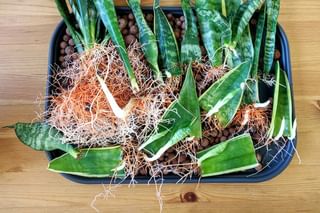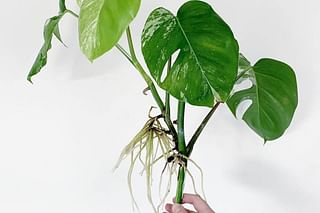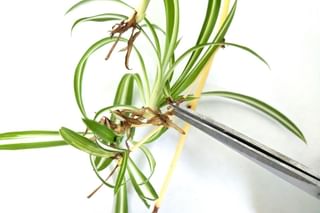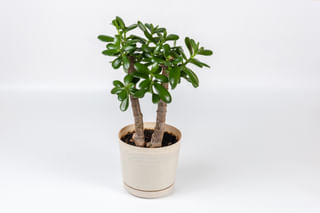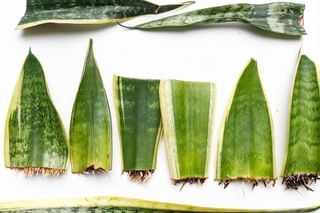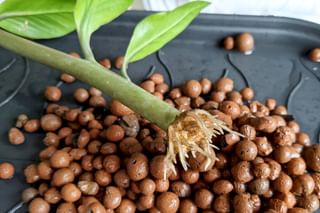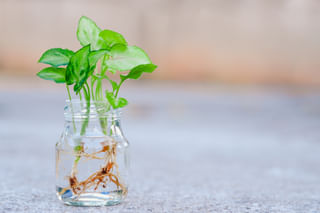Top 5 easiest houseplants to propagate
Discover the joy of propagating plants effortlessly with this expert guide on the top 5 easiest houseplants to propagate. Learn step-by-step techniques to multiply your plant collection and bring greenery into every corner of your home. Start your plant propagation journey today!
Have you ever wished you could grow more of your favorite houseplants without spending any money? You're in luck! Propagation, a method of producing new plants from the ones you already have, might just be the solution you're looking for.
This plant care guide will take you through the basics of propagating houseplants: from understanding what propagation is to the step-by-step process of how to do it.
I've picked five of the most easily propagated houseplants for you to try first. Propagating these plants will teach you how propagation works and how you can propagate other plants like it. These easy-to-propagate houseplants will also take away your fear of cutting into your plant and give you the confidence that you can successfully propagate a plant!
These are the topics we're going to look at together:
Now, let's roll up our sleeves and get started, shall we?
What is plant propagation?
Plant propagation might sound like a big, confusing term, but it's just a fancy way of saying you're making more plants from the ones you already have. In other words, think of it as a reproduction process for plants. So why should you propagate your houseplants? Let's find out!
Why propagate houseplants?
There are a few great reasons to propagate your houseplants. The best reason of all is that you'll have free plants, but there are several other reasons why you might want to propagate your houseplant.
Sometimes, a plant might not be in great shape. Propagation can help you take a healthy cutting and grow a new healthy plant out of it. A great example of this is when you have a succulent that has root rot. The plant will die eventually, but it still has a few healthy stems and leaves. You can cut these off and grow a whole new plant.
Propagation is also a great way for you to share some plants with your friends and family. A propagated plant makes a lovely and eco-friendly gift.
And last but not least, propagating your plants is fun! It's very fulfilling to see baby plants grow up to be fully-grown plants! With just a few plants, you can create an indoor jungle if that's what you want. You can make your house as green as you want without having to spend more money.
Top 5 indoor plants that are easy to propagate
There are a lot of houseplants to choose from, but if you want to have the highest chance of success when propagating your houseplant, your choices are a little more limited. In this section, we're going to look at 5 plants that I've found are perfect for beginners to propagate.
The steps to take to propagate these houseplants are quite simple and easy to do right. Your chances of success are also much higher when these houseplants, so you'll quickly gain confidence in your propagating skills.
Let's look at the 5 easiest houseplants to propagate!
Pothos (Epipremnum aureum)

One of the most popular and easiest indoor plants to propagate is the Pothos, also known as devil's ivy. This plant is ideal for propagation because its vine cuttings grow roots very quickly in water. All you need to do is cut the stem just below a leaf node, where the leaf meets the stem, and place the cutting in a jar of water.
Now you have to wait for about 2 weeks for roots to appear. You can leave the cutting in water for a few weeks until the roots are 2-3 inches long. At this point, you can plant the cutting in the soil and you've successfully propagated a Pothos.
Now you can take care of this plant like it's an adult plant. If you'd like to know more about taking care of this plant in detail, have a look at Golden Pothos.
Spider Plant (Chlorophytum comosum)
The Spider plant, with its hanging leaves and baby plant sprouts, is another great choice. The baby plants, known as spiderettes, can be snipped off and placed in water or soil to grow their roots. These baby plants grow roots almost as quickly as the Pothos and can be planted in soil when the roots are 2-3 inches long.
These spider plant babies grow quite quickly and could even start to grow their own babies in the same year if you've propagated them in early spring.
If you'd like to know more about taking care of this plant in detail, have a look at Spider plant.
Jade Plant (Crassula Ovata)
Jade plants are succulent plants with beautiful fleshy leaves. You can propagate them by taking a stem or leaf cutting, letting it dry out for a few days to form a callus, and then planting it in the soil. They need excellent drainage, so be sure to plant them in a pot with a hole in the bottom.
Jade plants are very easy to propagate because it stores a lot of moisture in their stems and leaves, which makes it easy for a cutting to grow roots. The cutting can take care of itself for quite a while, so the chances of success are high.
If you'd like to know more about taking care of this plant in detail, have a look at Jade Plant.
Sansevieria
Sansevieria, or mother-in-law's tongue, is famous for its tall, edged leaves. You can very quickly get more of this amazing plant by cutting the sword-like leaves off and rooting it in water or LECA. If you've got a very large leaf, you can even choose to cut it into multiple smaller sections and grow a new plant from each of these.
The Sansevieria cuttings do root quite quickly and it can be quite addicting to propagate this plant. I've found that propagating this plant in water or LECA gives you the highest chance of success and propagating it in soil is often not a very effective way of growing new roots.
If you'd like to know more about taking care of this plant in detail, have a look at Sansevieria.
ZZ Plant (Zamioculcas Zamiifolia)
The Zz plant, with its shiny, dark green leaves, is known for its drought tolerance and low-light requirements, making it an excellent choice for beginners. It can easily be propagated through stem cuttings or by dividing the bulb-like rhizomes at the plant's base.
Stem cuttings are very effective for this plant and cause the least amount of stress to the plant, so I recommend you choose this method of propagation. After you've taken a stem cutting, let it dry out for 2 days and then you can put it in a jar with water. Now you'll have to wait for roots to grow.
Roots grow quite quickly and once those have formed, the cutting will also start to grow a new rhizome (the bulb). This will let your plant grow new stems soon after.
If you'd like to know more about taking care of this plant in detail, have a look at ZZ plant.
Step-by-step guide to propagating houseplants
Now that you've seen some of the easiest plants to propagate, let's have a look at some of the different methods you can use for these plants when it comes to propagation.
Preparing the mother plant
The "mother plant" is the plant you'll be taking a cutting or division from. Before you begin, it's crucial to ensure the mother plant is healthy and mature as young or sick plants may not survive the propagation process.
Here's a brief checklist to prepare your mother plant:
- Check for signs of disease or pests. Healthy plants have vibrant colors and are actively growing.
- Water the plant the day before you plan to propagate because hydrated plants give the cuttings a better chance at success.
- Choose a mature, healthy part of the plant for cutting.
Method 1: Propagation by cuttings
Propagating houseplants is an amazing way to reproduce your favorite plant without buying a new one. And I'm here to tell you exactly how it works! Cuttings are the most popular propagation method, so let's learn about its five simple steps.
- Take a clean blade or pair of scissors and make a cutting just below a leaf node (bump on the stem where new growth originates).
- Remove the lower leaves, leaving only a couple at the top of the cutting.
- Place the cutting in a container with water or a pot with moist potting mix.
- Keep the cutting in a warm, bright location but away from direct sunlight.
- In a couple of weeks, look for root growth and make sure the cutting stays fresh and well-hydrated.
Method 2: Propagation by division
Propagation through division is a method that is ideal for houseplants that grow in clusters or have multiple stems like snake plants or ZZ plants. Here are some steps you can take to successfully propagate plants in this way.
- Gently remove the entire plant from its pot.
- Locate the areas where the plant naturally separates. This could be separate stems or split zones in the root system.
- Use clean, sharp scissors or a knife to separate the divisions.
- Replant each division in its individual pot filled with fresh potting soil.
- Water lightly and keep in a warm, bright location away from direct sunlight.
Common mistakes to avoid during propagation
Now that you've seen the two best methods to propagate houseplants, let's look at a few common mistakes you could make while propagating. If you made a mistake while propagating your plant, don't feel bad, everyone does. Not all cuttings will make it, no matter how well you take care of them, so just keep that in mind.
These are the most common mistakes to make while propagating your houseplants:
- Too much water: Overwatering can cause cuttings or divisions to rot. Only water when the top inch of the soil is dry.
- Low light: While direct sunlight is harmful, low light can slow down growth. Keep your plants in bright, indirect light.
- Ignoring the plant: Patience is the key! Propagation can take time, so don't forget to check in on your young plants regularly.
Caring for your newly propagated plants
After the cuttings have developed roots and you have potted them, your work is not done. These baby plants need the right care to grow strong and healthy. Let's take you through the process.
The importance of proper light and temperature
Light and temperature are crucial for your newly propagated plants. Much like how we humans need a balanced diet for growth, plants need balanced exposure to light and temperature.
Put your plants near a window where they can get tons of indirect sunlight. Direct sunlight can often harm your new plants by drying them out or causing sunburn.
The ideal temperature may vary, depending on the plant type. Still, a general rule of thumb is to keep the room between 65-75℉ (18-24℃). If it's too hot or cold, your plant may not grow properly or even die.
Watering your propagated houseplants
Water is one of the most important things all plants need to survive. This is even more important for newly propagated plants. But knowing how often, how much, and when to water can be tricky.
The key is to keep the soil moist, but not waterlogged, as this can cause root rot. A good starting point is to water once the soil's top inch feels dry to the touch. Remember, it's better to underwater than overwater.
When to fertilize your newly propagated plants
Now that your propagated plants have found a new home in a pot full of soil, it's essential to give them nutrients. And, that's where fertilizers come in. However, it's best not to fertilize right away. Instead, wait for a couple of weeks until the plant has settled into the new environment and shown some growth. Start with a balanced, easy-to-dilute liquid fertilizer and follow the manufacturer's instructions to avoid overfertilization.
The most important thing your small plants have to do is simply grow roots and establish themselves. The goal isn't yet to have these plants grow larger. This will come once they settled in their new growing environment after a few weeks.
Thank you for reading this post! I hope it helps you to keep your plants healthy and beautiful! If you're looking for more guides on specific plants, you can always request a plant guide to get a guide for the plant you have trouble with.
Test your plant care knowledge
Quiz completed!
Want to learn more? Sign up for my newsletter to receive free tips in your inbox!
Sign up now!